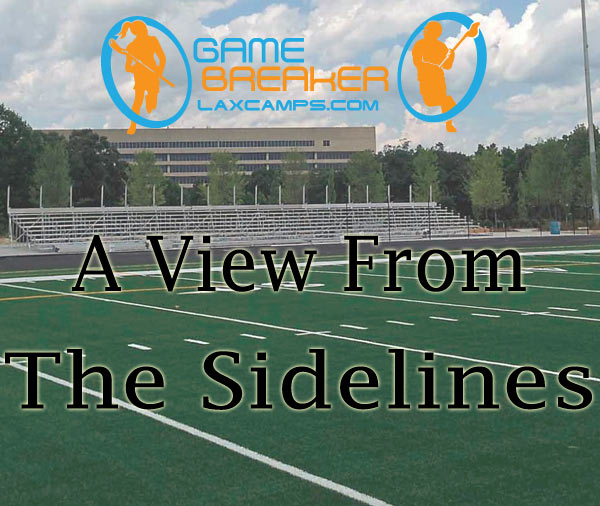Lacrosse and Field Hockey are Different Sports with Similarities

Many people believe Field Hockey and Lacrosse are the same game. The games do not have interchangeable gear or rules of play. To clarify, lacrosse is not the same sport as field hockey. While the similarities between field hockey and lacrosse are considerable, they are quite different sports.
Difference and Similarities Between Lacrosse and Field Hockey
Equipment
A field hockey stick is distinctively designed with a curved, hooked end, which is essential for the sport’s ground-based play. The curvature at the end of the stick is specifically engineered to allow players better control and maneuverability of the ball on the ground. The flat side of the stick is used for striking the ball, while the rounded side is generally not allowed to make contact with the ball in standard play. Field hockey sticks will vary in length and weight to suit players of different heights and strengths.
A lacrosse stick, however, often referred to as a “crosse,” is characterized by its long handle (also called a shaft) and a distinctive netted head. This head structure is designed for catching, carrying, and passing the ball through the air. The netting allows players to cradle the ball securely while running at full speed and to release it with precision and force. Lacrosse sticks come in different lengths: shorter sticks for attackers and midfielders for better control and maneuverability, and longer sticks for defenders and goalies for increased reach.
Ball Size
Field hockey balls are larger than lacrosse balls, starting at 8.8 inches and going up to 9.25 inches. Because field hockey involves the ball being hit, dribbled, and passed along the ground with a flat, hooked stick, a larger ball is more suitable for this type of play, as it allows for better control and visibility on the ground. The ball can move quickly across the field surface but is still large enough to be effectively controlled and hit with the stick.
Lacrosse balls are smaller, however with a circumference between 7.75 and 8 inches, because the ball is designed to be caught, carried, and thrown. A smaller ball facilitates easier handling and control within the netted head of the lacrosse stick. The size and weight of the ball are optimized for quick passing and shooting through the air, requiring precision and agility from the players.
Protective Gear
Lacrosse players typically wear eye protection and mouth guards due to the aerial nature of the game. In contrast, field hockey players wear mouth guards and shin guards, as the game primarily involves ground play.
Gameplay Strategy
In both sports, the movement of the ball—whether along the ground in field hockey or through the air in lacrosse—dictates the overall strategy.
In field hockey, the gameplay strategy is heavily centered around ground play. Teams often employ formations like 4-3-3, which includes four defenders, three midfielders, and three forwards, to maximize control over different areas of the field. The strategy involves precise passing and dribbling, sometimes even lifting the ball, to skillfully navigate through opponents. Players are required to strategically position themselves to effectively receive passes and advance the ball towards the goal. On the defensive side, the focus is on intercepting passes, tackling, and blocking shots while keeping the ball predominantly low to the ground. Additionally, set pieces like corner shots and penalty strokes play a critical role in the game’s strategy, demanding well-rehearsed routines and coordinated team efforts.
In terms of offensive strategies, lacrosse gameplay involves fast breaks, pick and rolls, and precise shooting, requiring seamless coordination among attackers, midfielders, and defenders for successful ball advancement and goal-scoring. Defensively, the game involves strategic tactics like stick checking, proper body positioning, and maintaining strategic formations to effectively intercept passes and regain possession of the ball. In addition to these field strategies, lacrosse goalkeepers play a crucial role; they must be adept at handling aerial shots and react quickly to the fast-paced offensive plays, which is a key difference from field hockey goalkeeping that also demands skilled goalkeepers but with different focuses.
Season and Game Division
Lacrosse is predominantly played during the spring and summer months, taking advantage of the warmer weather which suits its fast-paced, high-energy gameplay. The games in lacrosse are divided into quarters, a structure that allows for regular intervals for strategy adjustments and rest, reflecting the intense physical demands of the sport. This division also adds a dynamic element to the game, as teams have multiple opportunities to reassess and change their tactics at each break.
Field hockey is typically played in the fall, a time when the cooler weather is conducive to the sport’s endurance-based, continuous play. The game is structured into halves, which provides a longer, uninterrupted period of play. This format demands sustained physical and strategic effort from the players and creates a different flow of gameplay compared to lacrosse. The half-time break in field hockey is a crucial interval for teams to regroup and plan for the second half, requiring endurance and strategic depth from the players.
Team Composition
In lacrosse, the team composition on the field consists of ten players, each playing a specific and crucial role. The offensive segment is made up of three attackers, who are mainly responsible for scoring goals and are typically positioned near the opponent’s goal. The team’s midfield unit comprises three players, who are versatile in their ability to play both offense and defense, often covering significant ground to transition the ball between the attackers and defenders. The defensive line has three players, focused on protecting the team’s goal area and preventing the opposition from scoring, in coordination with the goalie. The goalie, as the last line of defense, has the critical task of guarding the goal, making key saves, and initiating the team’s offensive moves.
On the other hand, a field hockey team on the field consists of eleven players. This includes four forward line members, who lead the attack and are often the primary goal-scorers. The midfield is composed of three players, similar to lacrosse, playing a dual role in supporting both offense and defense, and controlling the game’s pace. Three players make up the defensive unit, tasked with blocking opponent attacks and shielding their goal area. The goalkeeper, a vital player in the team, is responsible for defending the goal, making crucial saves, and often directing the defensive strategy.
Gender Differences in Lacrosse and Field Hockey
As well as differences between field hockey and lacrosse, there are differences even still between genders within field hockey and lacrosse.
Differences Between Men’s and Women’s Lacrosse
Women and Men’s lacrosse have many differences in the rules of play. Physical contact is the biggest difference between the two sports. Body checking is legal in the men’s game, but it is not in the women’s game. Because the women lacrosse players do not have physical contact in their sport, they do not need the same amount of protective gear worn in men’s play.
The pockets on women’s lacrosse sticks have strung nets instead of the mesh nets found in men’s sticks. Women’s lacrosse requires that the top of the ball remain above the sidewall if and when it’s in the pocket. These differences make shooting and stickhandling in women’s lacrosse more difficult than in men’s lacrosse.
In men’s lacrosse, the field is 110 yards long by 60 years wide. The women’s field is a little bit larger at 120 yards long by 70 yards wide, which helps accommodate the two extra players women are allowed in their game.
Differences Between Men’s and Women’s Field Hockey
Women and Men’s Field Hockey have very few differences because field hockey is primarily viewed as a women’s sport in the United States. Men do not have the opportunity to play field hockey in college, but they do have the opportunity to play on the USA International team. Field hockey is used as a Title IX sport in the US to offset the number of men who play football.
Experience the Differences Between Lacrosse and Field Hockey Yourself
Now that you know the differences between lacrosse and field hockey, it’s time to experience them for yourself. Every year, GameBreakers Lacrosse Camps hosts women’s and men’s lacrosse camps all across the country. Learn more about our camps and our staff to see why we host the best lacrosse camps for all ages and skill levels.



